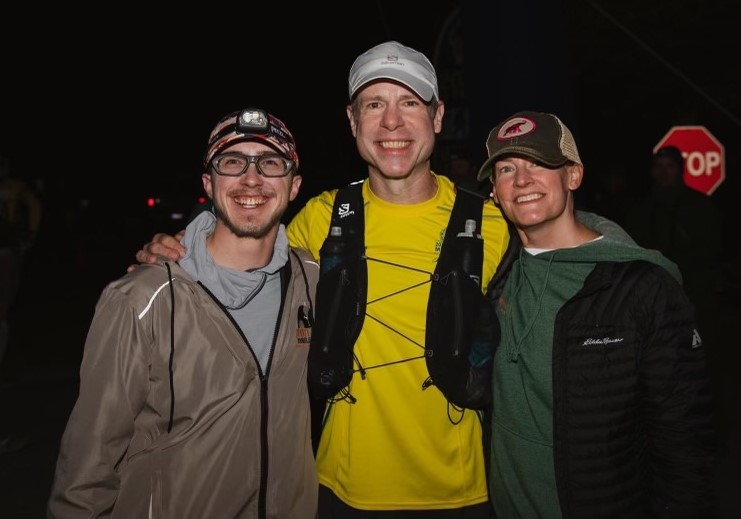
My Usual Sleep Saga
2022 was my sixth year running the Moab 240, and my fourteenth 200+ mile race. I knew the course, knew how my body would react to the heat, and, unfortunately, I also knew there was a good chance I’d get very little sleep the night before the race. The sleep issue had plagued me in 200-milers since 2017, and I had gotten to the point where it felt like a major victory anytime I slept five hours or more during those crucial hours before toeing the start line.
Knowing the likelihood of not getting much pre-race sleep, I made two separate sleep plans for during the race. I discussed both of them with Heather, my girlfriend and sole crew member. The first plan assumed I got a reasonable amount of sleep before the race, maybe four or more hours. If I was fortunate enough to get that much sleep, I would not sleep for any large blocks of time during the race, but would instead rely on three or four 10-minute dirt naps on the side of the trail during the second night and the third day.
The second plan was for the more likely scenario, getting less than four hours of sleep the night before the race. In that scenario, I would still run through the first night of the race without sleeping. Then, on the second night, when I arrived at Road 46 aid station, I would take an hour to get a solid block of sleep. From Road 46 to the finish, I would allow myself two or three 10-minute dirt naps whenever and wherever I needed them.
I even made a point of telling Heather that if I slept for only a couple hours before the race, it was almost a certainty my resolve would weaken once I arrived at Indian Creek aid station on the first night, mile 71. I warned her that once I sat down, I would likely convince myself I wanted to sleep there. But she was not supposed to cave in to my inevitable requests to lie down. Sleeping the first night, I said, was not going to help me achieve my goals, and she should push back on any arguments I might make regarding how important it is that I lay down to sleep that early in the race.
As it turned out, the night before the race I slept from 11:30 PM to 11:50 PM. Twenty minutes total sleep all night. When I crawled out of bed in the morning, I was disappointed but I was fully committed to not letting this obstacle derail my goals. I’d made a plan for this eventuality, and now I just needed to execute that plan. It was time to move forward.
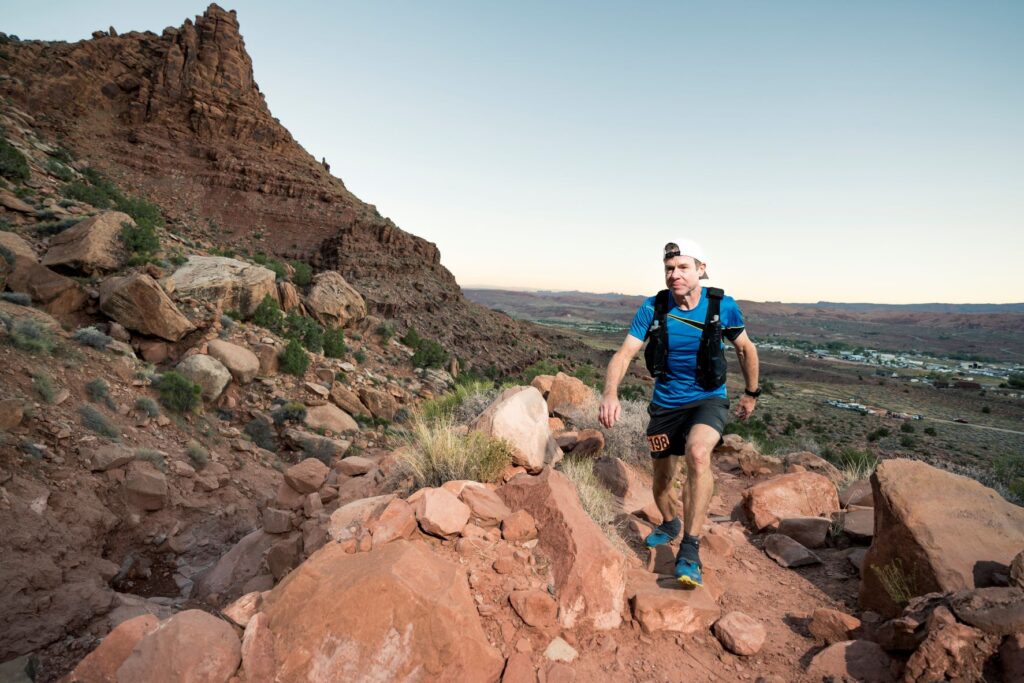
Start to Amasa Back (mile 0 to mile 17.8)
247 runners toed the starting line at Moab. I began the race with a light pack, carrying only the mandatory gear, plus two bottles of fluid and enough food to get me 18 miles to Amasa Back aid station. There, Heather would be waiting with a fresh pack of supplies.
The first three miles of the course are on flat roads through the town of Moab. Jeff Browning served as de facto pace setter for the front of the pack, moving efficiently along the roads at an easy clip. Jeff had been coaching me since January of 2022, and we’d met for the first time in person for a cup of coffee the morning before the race. I considered Jeff to be the race favorite, but I would do my best to challenge him. I knew that beating Jeff would be a stretch, so my difficult but more realistic goal was to finish in 2nd or 3rd place. Failing that, somewhere in the top ten would be my fallback goal.
I maintained a decent pace through town, trailing a short distance behind the true leaders in roughly 10th place. Along the west edge of Moab, the course cut up onto Pipe Dream, a singletrack trail that weaves a crooked path below the mesa which dominates the Moab skyline west of town. The runners started spreading out a little more after the transition to singletrack, making it difficult to see more than one or two people at any given moment. I kept my effort easy and steady, passing a few runners as they slowed down, and arrived at the first aid station at 7:25 AM.
The Hidden Valley aid station at mile 9 has always seemed superfluous to me. Later, during the hottest part of the day, all of us would pass through a 26-mile section that has no real aid stations and with little protection from the blazing sun. So, having an aid station 9 miles into the race during the cool and comfortable first morning seems almost like we’re being coddled before being thrown to the wolves. That said, I still enjoy Hidden Valley aid station because it allows me to carry less water through the first portion of the race. As in previous years, I stopped for less than a minute, long enough to top-off my two bottles before heading onto the 8-mile route to Amasa Back.
After the rocky ascent from Hidden Valley to the top of the mesa, I found myself running with Ricky Roane and Patrick McClellan in a collective third through fifth place. The three of us stuck together to the end of the Moab Rim trail, splitting up after the steep slickrock descent to Kane Creek Boulevard. Ricky and Patrick sped up a little more than I did upon hitting the pavement, leaving me a minute or two behind them by the time I got to Amasa Back.
As always, Heather was ready for me when I arrived at the aid station. Her patience and ability to remain constantly alert has always been amazing to me. At many of the Moab 240 aid stations, it’s impossible to get internet coverage, which means a runner’s crew can’t view the live tracker to see where their runner is. As a result, the crew has to make a guess regarding when their runner will arrive, and then stand around waiting for what could be a few minutes or a few hours until their runner finally shows up. To successfully do that time and again, aid station after aid station, race after race, is impressive. I’m very thankful for Heather’s support.
When I rolled into Amasa Back, Heather got me through the aid station and back on the trail in only a few minutes. I wouldn’t see her again for another 54 miles until the next crewed aid station at Indian Creek.
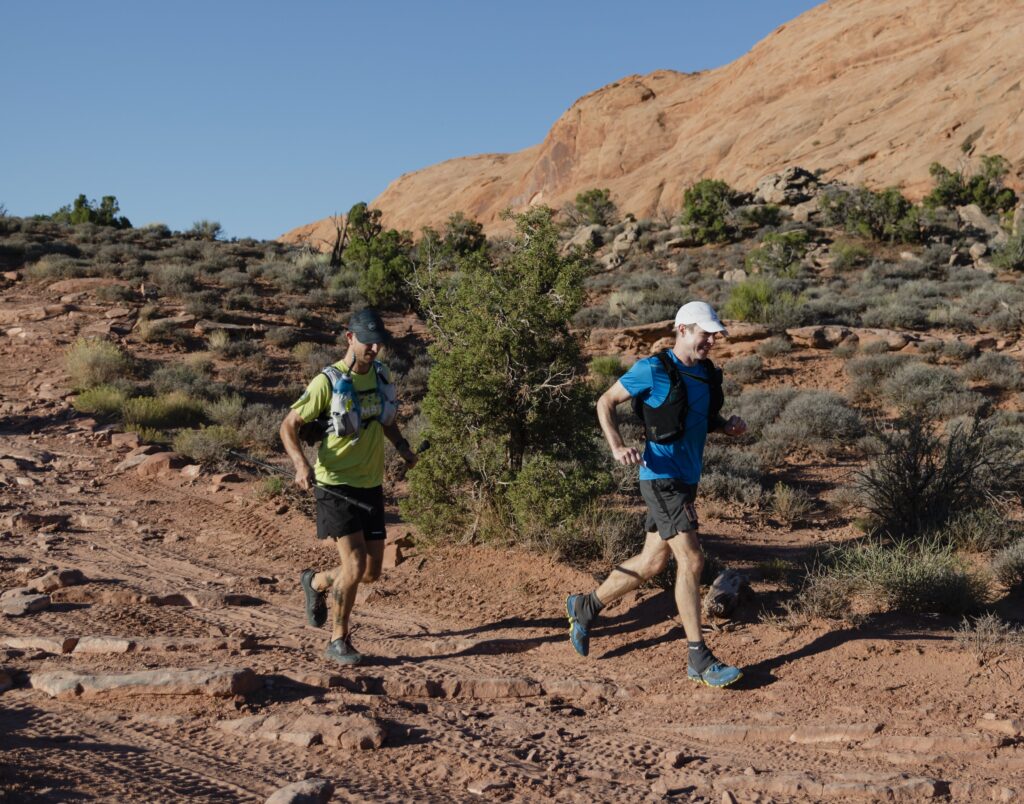
Amasa Back to Indian Creek (mile 17.8 to mile 71.3)
It was 9:20 AM when I left Amasa Back. The desert was beginning to warm up. The rest of the day would involve a climb to the top of another mesa, a steep, technical descent of Jackson’s Ladder, and then a long trek through 50 miles of hot, exposed valley on a 4 x 4 road.
After the descent into the valley, I discovered the 4 x 4 road was washed out and even muddy in places. I knew it had rained heavily in the area in the week leading up to the race, but I hadn’t quite expected this. I was used to the sun quickly baking everything around Moab into dry, powdery sand, so picking my way around mud slicks during this portion of the course was a new experience.
I moved steadily, but not particularly quickly, along the road. In a couple of the hotter years this same valley had bitten me pretty badly when my fluids and electrolytes had gotten out of balance, so I made a point of metering my water, electrolytes and food carefully in a manner I first successfully utilized at the Bigfoot 200 earlier in the year. In retrospect, the approach I took with this was a big success which I will continue to refine in the races to come.
I hadn’t seen any other runners since shortly after Amasa Back, so I found it interesting that my arrival at Base Camp aid station coincided with another runner’s departure. I didn’t know who it was, but I was relatively certain he was in fourth place. Keeping my stop brief, I filled up my bottles with water and electrolytes and then moved on. I was carrying enough calories in my pack that there wasn’t any need to eat the food being offered on the aid station tables.
From Base Camp it was 26.5 miles to the next aid station, The Oasis. Because of the distance without aid, and because most of the runners passed through this portion of the valley during the heat of the day, the race staff always left a collection of large water jugs 4.5 miles into the section. It was at this water stop that I caught up to the runner I’d seen from afar when I arrived at Base Camp. We chatted briefly as we filled our bottles, and then I moved on ahead of him.
When I finally reached The Oasis, mile 59, I was surprised to find Alyssa Clark sitting in a camping chair and looking a bit rough. I’d been told she was a professional runner with a great string of successes, so I knew she’d be a tough competitor. I also knew that in races of this distance most of us would go through and emerge from rough patches multiple times, so I didn’t count Alyssa out merely because she happened to be struggling at a time when I was feeling relatively strong.
By this time, I needed solid food beyond the plantain and banana chips that had largely been sustaining me, so I ate some cups of mashed potatoes the volunteers had made. As always, the volunteers at The Oasis were wonderful, and did everything they could to help me.
The potatoes went down well, and I should have stopped before I felt the first twinge of something not quite right with my stomach. Unfortunately, in my attempt to get my body stocked up on calories, I ate one or two bites too many. A familiar queasiness rose in my stomach. I stood, walked to the edge of the aid station, and then vomited onto the dirt and prairie grass. To my pleasant surprise (if there’s such a thing as a pleasant surprise while vomiting) it was almost entirely the fluids that came out, while the more calorically dense mashed potatoes remained in my stomach. And with that, the queasiness vanished. I took this as my cue to depart.
Grabbing my pack off the back of the chair I’d been sitting in, I thanked the volunteers and then got back onto the 4 x 4 road that would take me the rest of the way to Indian Creek. With Alyssa still sitting at the aid station, this put me in 3rd place behind Ricky Roane and Jeff Browning.
The twelve, largely-flat miles to Indian Creek should have been easy. Evening was already upon us, and cooler temperatures would soon follow. For some reason, it was a very slow section for me. There was another of the water stops 6 miles after The Oasis, and it seemed to take me forever to reach it. At some point I even checked my GPS to see if I’d passed the water stop without seeing it. When I start verifying mileage on my watch, it’s usually an indictor that I’m not moving well and that my psychological state is in some kind of low. With only twenty minutes of sleep the night before the race, I was essentially going into my second night without any measurable sleep, so I suppose my state of mind was understandable, but it certainly wasn’t desirable.
Indian Creek to Shay Mountain (mile 71.3 to mile 121.6)
When I arrived at Indian Creek, I checked in with the volunteers and then followed Heather to our crew vehicle, which was her Toyota Tacoma pickup truck. She’d positioned a camping chair behind the open tailgate of the truck. Once I settled into the chair and started getting some calories into my depleted body, an idea crept into my mind. At first, I thought I should keep the idea to myself. But, the longer I sat there, the more the idea seemed like a truly brilliant one. I had a feeling the idea was not going to go over well with Heather, but after a few more bites of food I couldn’t resist pitching it out there anyway.
“I’m feeling really tired,” I said.
Heather was working on filling my pack with food and fluids for the next couple sections. She didn’t even glance in my direction. She already knew where this was going.
“I think it might help if I crawled into the bed of the truck and took a short nap,” I added.
She finally looked over at me. I could tell from her face that she didn’t share my enthusiasm for this great idea of mine. “You told me you would say that,” she said. “You said you would want to sleep at Indian Creek, and that I should remind you that you’re committed to not sleeping the first night even if you got very little sleep the night before.”
“Just for fifteen minutes,” I said. “I could cover up with the blankets. I’m shivering right now. It would allow me to warm up.” Surely, she could see the irrefutable logic of my idea.
“You specifically told me that no matter how much you think you want to sleep, I should remind you that because of your race goals, you don’t really want to sleep the first night. You want to keep moving.”
I gazed longingly at the bed of the truck.
“You probably need to start running before your shivering gets worse,” she said.
And she was right, of course.
Slightly unhappy, but knowing I was making the right decision, I put on my pack and got moving.
It turned out Alyssa had passed me during my time at Indian Creek. I caught up to her and her pacer about a mile after the aid station, passed them, and then tried to put a little distance between us during the easy, paved road section before the turnoff onto the singletrack which would take me to The Island aid station. I gained a little ground on them, but it was a small enough gap that even 10 miles into the 15-mile section I was still occasionally catching a glimpse of their headlamps when the trail would hook back on itself to the left or the right.
The journey from Indian Creek to the Island aid station was uneventful aside from an unfortunate incident when I’d gone slightly off-trail. While looking at the GPS on my phone to navigate back onto the course, I stepped onto a slick patch of mud that launched me forward onto my hands and knees on the sloppy ground. Still in my hand, my phone had been jammed down into the thick mud as if I were planting a flag.
I lifted my phone out of the muck. Already knowing what I would see, I shone my headlamp onto the bottom of the phone and saw thick mud jammed into the charging receptacle. Major phone surgery was going to be needed to clear enough mud out to charge the phone, and I didn’t have the means or the time to clean it during the race. I shrugged it off, and hoped my phone’s battery would last the remaining 160 miles without any charging. I typically kept my phone turned off unless I needed to use the GPS, so I figured there was a good chance the battery might actually survive the race.
Morning had arrived by the time I hit Bridger Jack aid station at mile 103. I spent 14 minutes there and then decided I needed to regain my forward momentum. My knees bothered me during the short road portion, and it only got worse after I made the sharp right turn onto the slippery, rocky trail that would take me down to the dry wash. Unlike most of the previous years I could recall, the dry wash was not actually dry. The hard rains had left it muddy in a lot of places, so navigating the wash required intermittent skirting of the edges.
The first of the two big ascents toward Shay Mountain went quickly for me, but at some point, my energy began waning. My rate of food consumption had tapered off, and I wasn’t consuming as many calories as my body needed. The granola bars, plantain chips and banana chips were no longer going down as easily as they had been. I needed to make a change to my diet that would keep me eating regularly, or my energy level would drop even further.
Knowing that pancakes and mashed potatoes usually work well for me at aid stations, I decided I’d try carrying them between aid stations as a supplement to the other foods Heather had been stocking in my pack. This seemingly innocuous decision would have repercussions much later in the race.
When I arrived at Shay Mountain aid station, mile 120, I learned that Ricky Roane was having some problems, and was dropping out of the race. I knew from my own DNFs how it felt to drop out, so I never wished it on anyone. But I also knew it meant that I had officially moved into second place.
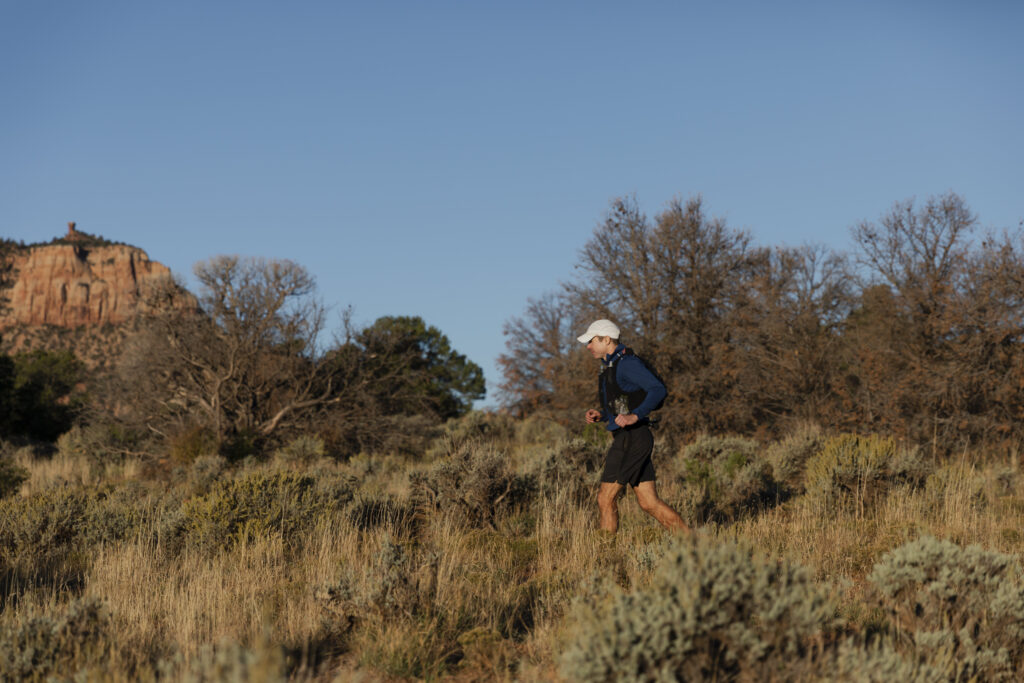
Shay Mountain to Road 46 (mile 121.6 to mile 167.3)
Carrying pancakes and mashed potatoes in my pack as I departed Shay Mountain, I felt my energy tick up a bit in the ensuing miles as I snacked on the carbohydrate-rich foods. I kept that fueling strategy through the remainder of the race. With my body better fueled, and despite my lack of sleep, I managed to keep things together mentally until about 37 miles later, a few miles past Needles aid station.
I departed Needles at 11 PM of the second night moving slowly. This part of the course consisted of a flat dirt road with occasional low, gently sloped hills. With such easy, non-technical ground to cover, my mind didn’t need to be as engaged as it typically was while traversing technical or challenging terrain. Add to that the fact that I was now into my third night with no real sleep, and my mind started shutting down. I kept moving forward, but my brain slipped into a dream…
…In my mind all I could see was this endless list of names. Some part of me was still perceiving the terrain around me, otherwise I would have tripped and stumbled as I continued moving forward. But my entire conscious focus was on this imaginary list. Two columns of names scrolled before me. Name after name after name. These names were supposed to be residents living on either side of the dirt road I was traversing – Looking Glass Road. It was my task to verify that all of the people on my endless list were indeed residents. It seemed like a daunting task, possibly even insurmountable. But I knew I had to get it done. It didn’t occur to me that there were approximately zero homes scattered along this entire, 12-mile road, and therefore approximately zero residents. I just knew I needed to complete my task.
I don’t know how long I ran and walked while experiencing this list-oriented dream, but at some point, I came out of my dreamlike state just enough to realize I was running the Moab 240 and was moving toward Road 46 aid station. The fogginess and lack of clarity remained, but the shred of my mind that had recaptured a sense of logic was worried I was going to slip back into that full-on dreamlike state again. So, even though my phone had no service, I texted Heather, apparently hoping the message would somehow be delivered when I regained cellphone coverage.
My text read, “When I get to Road 46 I’m going to need your help. I’m very confused about what’s going on. I’m afraid I will show up and not know what’s happening.”
I’m sure that would have been a scary text to receive from someone at this stage of a 200-mile race. I’m not sure what Heather would have done had she actually received it. Drive out to find me? Mount a rescue effort? Either way, a did-not-finish or a disqualification might have occurred. Fortunately, the message was never delivered.
I ended up putting my earbuds in and playing music in an effort to engage my brain enough to keep me more alert. It helped, but didn’t entirely stop my mind from occasionally slipping between the foggy dreamlike state and a clearer one.
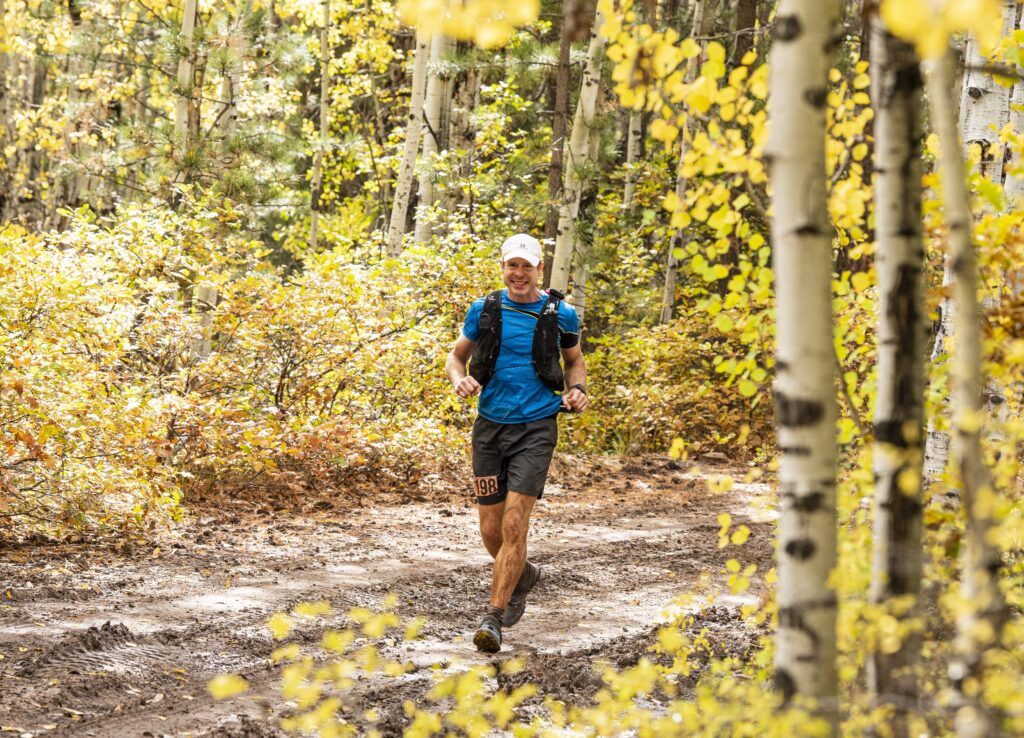
Road 46 to Geyser Pass (mile 167.3 to mile 200.0)
Mentally, I was noticeably sharper by the time I arrived at Road 46. I ate half of a burger and drank some Coke and hot chocolate. Then, in accordance with my pre-race sleep plan, I passed out on a cot in the sleeping tent. Heather woke me up an hour and fifteen minutes later. I could easily have slept another several hours, but I knew I needed to get moving. I ate another serving of burger and drinks before Heather brought mashed potatoes and pancakes the aid station volunteers had whipped up for me. She put them into plastic sandwich bags for the next section, tucked them into my pack, and then I headed out for Pole Canyon.
Pole Canyon aid station, mile 185, was a short stop for me. I refueled, stocked my pack with potatoes and pancakes from the volunteers, and then hit the trail to Geyser Pass around 10 AM. I do a lot of climbing as part of my regular training throughout the year, so the ascent out of Pole Canyon was ordinarily something to look forward to. Instead, I found myself bothered by the twisting, winding nature of the trail through this portion of the course. It made me feel as if I was following a directionless route that was forever turning inside itself. Intellectually, I knew this wasn’t true, and I’d run the course enough times to know better, but for some reason I couldn’t help feeling that way. I don’t know if that mental struggle prevented me from pushing my body as hard as I typically do through this section, or if my body was already struggling in some way that was negatively impacting my mental state, but in either case I moved very slowly through a section that had always been a good one for me.
During the latter portion of the route to Geyser Pass, the skies opened up with a deluge of hail. I put on my waterproof jacket, tugged the hood over my head, and shuffled along the trail.
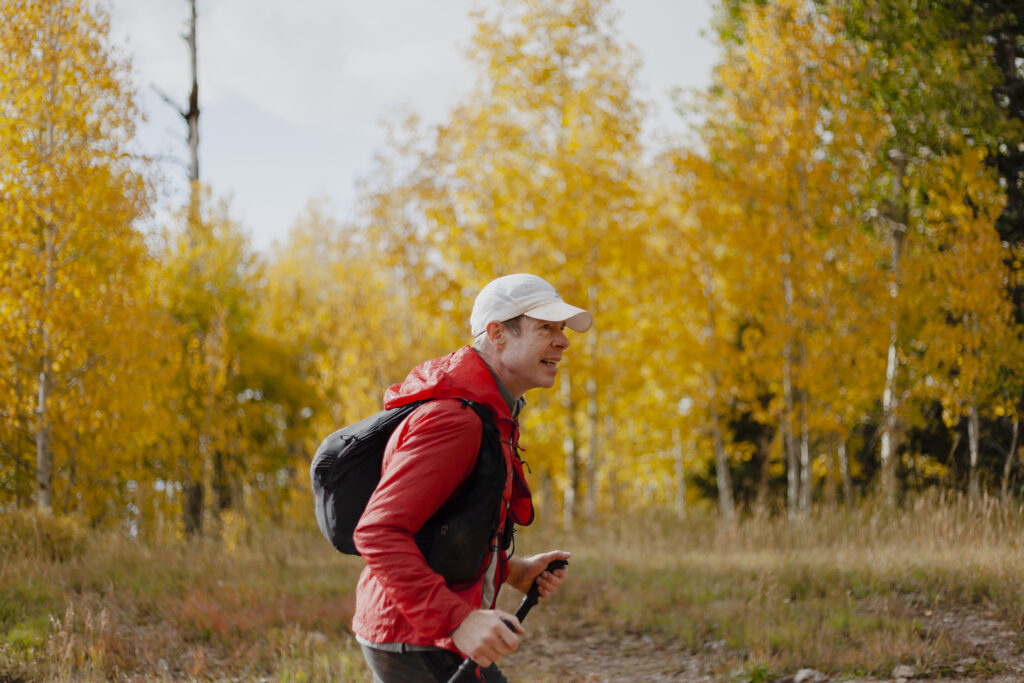
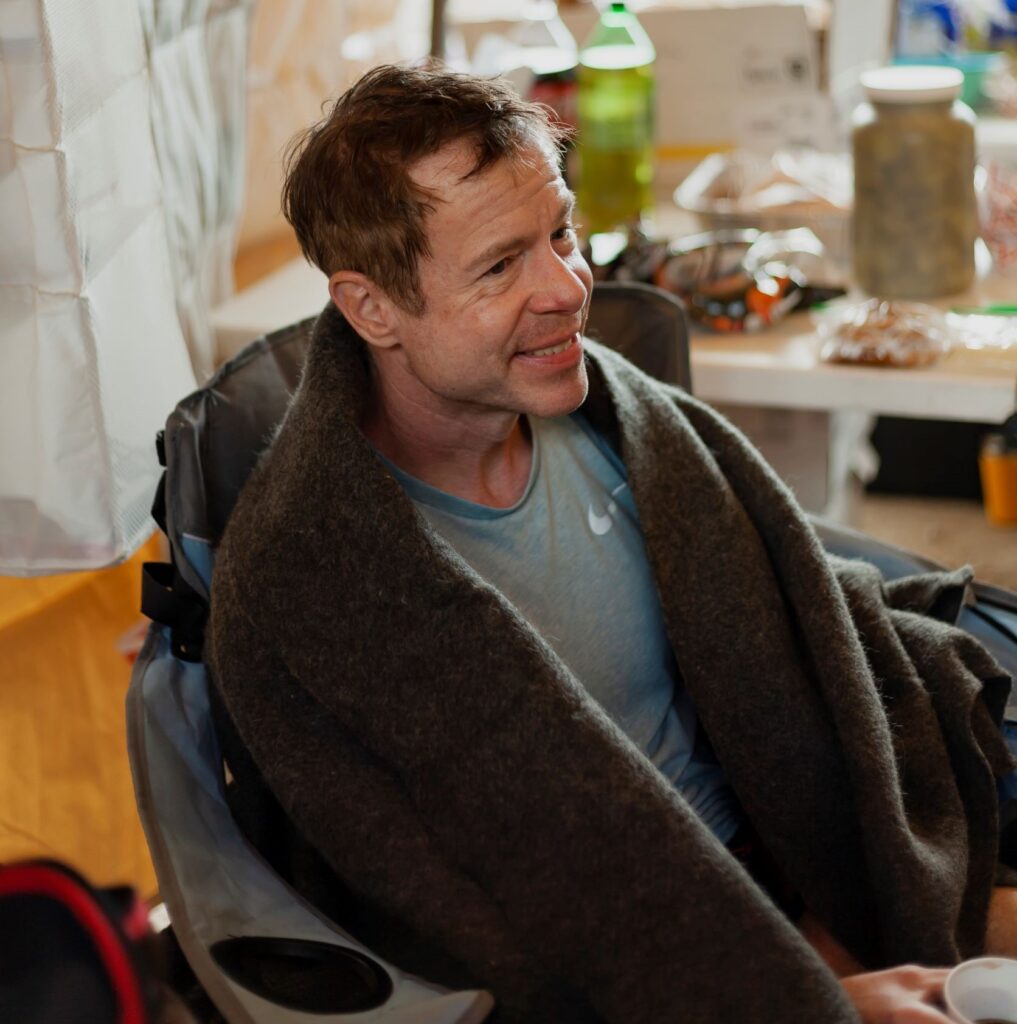
Geyser Pass to Finish (mile 200.0 to 238.2)
Heather was waiting for me at Geyser Pass aid station. The hail had stopped by then, so I took the time to change out of my wet socks and shoes, and then Heather got me on my way. In all, I was in good spirits and kept the aid station stop to fifteen minutes.
Geyser Pass to Porcupine Rim is a 20-mile route that includes a lot of non-technical, very runnable downhill dirt roads, and I’ve typically turned this into an internal contest to see how fast I can push myself this late in the race. But that didn’t happen this year. Instead, I “ran” this section more than four minutes per mile slower than the years that had gone poorly for me, and eight minutes per mile slower than my good years. I probably could have crawled faster.
The muscles in my lower back and sides had begun tightening in a way I’d never experienced. I couldn’t have squeezed those muscles harder even if I had tried. Despite the incredible muscle tension, it was nothing like a cramp. It lacked all of the pain associated with a cramp. It pulled my upper body into a lean to the right, and radically altered my gait to the sort of slow trudge one might expect from a lethargic zombie. And there was nothing I could do to correct it. My right leg, in particular, seemed affected by the lean, and refused to take a full-length stride unless I focused on it.
In the past, I’d occasionally I’d seen runners finish 200-milers with their bodies contorted into what looked like an incredibly uncomfortable and inefficient lean. At the time, I’d wondered if there was some means by which they could force themselves to stand up straight if they only tried hard enough. Now I knew: it was simply impossible for them to get the muscles to release. No physical effort or force of will was going to allow them to stand straight or to move normally.
As a result of the restricted stride length of my right leg, I would inevitably and repeatedly drift to the right until I came to the edge of the road or trail I was traversing. Then my tired mind would realize what had just occurred and I would correct my direction of travel for the next few minutes until it all happened again. And again.
My transformation to a leaning, shambling zombie didn’t happen all at once. The change was gradual, but had become undeniable by the time I’d made it ten miles from Geyser Pass. In retrospect, I think the seeds for the problem were sown back around mile 120 at the Shay Mountain aid station when I shifted away from banana chips to favor pancakes and mashed potatoes. I gave up my primary source of potassium when I ditched the banana chips. Ordinarily, the potatoes would have made up for that shortage, but I ended up eating much more of the potassium-free pancakes than I did the potassium-rich potatoes throughout the latter half of the race. Compounding this was the fact that this year I’d switched from an electrolyte capsule containing a fair amount of potassium to one that contained only trace amounts of the mineral. As I would learn later, extreme potassium deficiency is one of the primary causes of the dreaded ultrarunner lean.
By the time I arrived at Porcupine Rim aid station, the lean and the slow, stiff movements were apparent to anyone who saw me. Although it wasn’t yet as bad as it was going to become, the problem was obvious enough that, unbeknownst to me, a couple people shot videos of my entertaining shamble. I’ll include a link at the bottom of this race report for anyone who wants to see what it looked like.
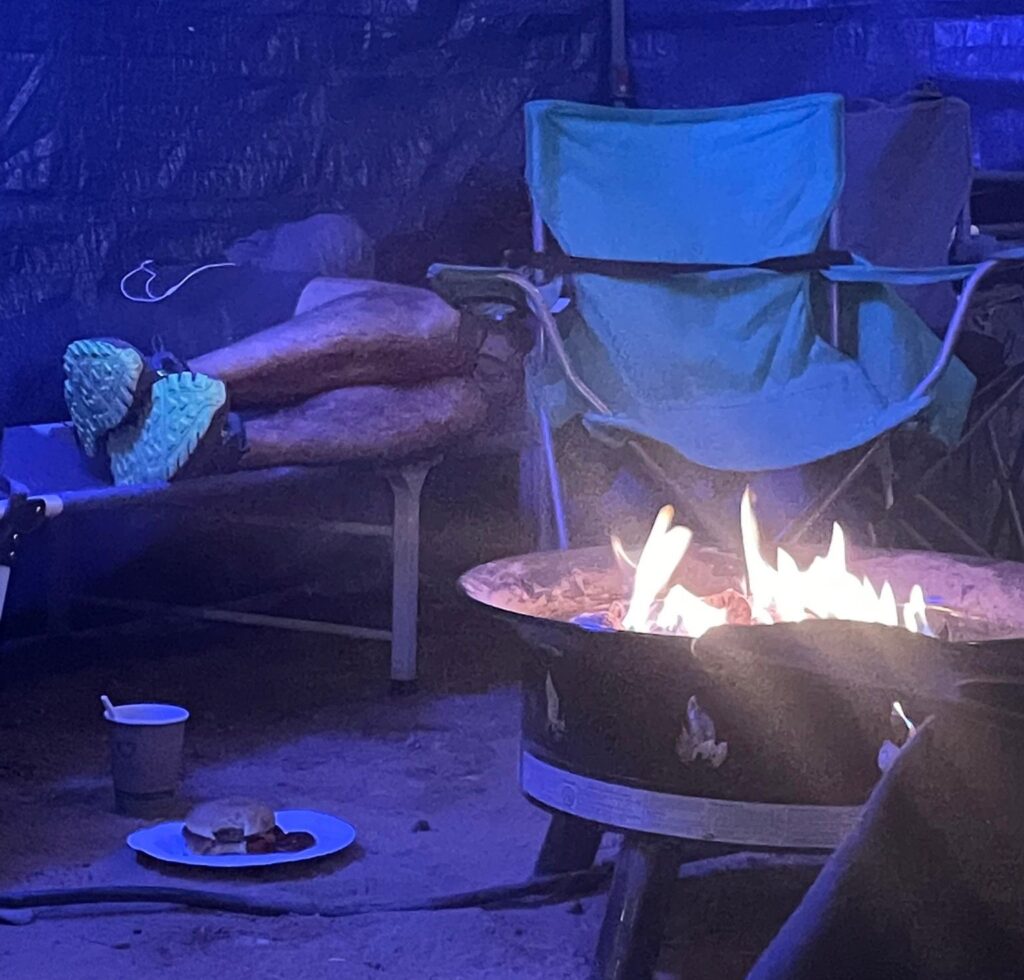
At this point in the race, I had held onto 2nd place for 100 miles. With a lead of almost 5 ½ miles on the 3rd place runner, and only 18 miles to the finish, I thought that, surely, I could press through this muscle issue long enough to cross the finish line ahead of the runners pursuing me.
In the past, Porcupine Rim had always been an aid station where crew was allowed, but this had changed for the 2022 race due to parking issues. However, as at most of the no-crew-allowed stations, coordinating in advance to volunteer at an aid station was a way for a crew to get access to a station that wasn’t otherwise accessible. Heather and I had volunteered to help after my finish, so she was able to meet me at Porcupine Rim as I came through. We’d both enjoyed having her pace me for the last 18 miles of the 2021 race, so we thought it would be fun to repeat that experience in 2022.
Heather and I left the aid station together fifteen minutes after my arrival, ready to get this thing done. My ailing back had a different plan.
We were moving slowly as we departed, and we only got slower. By the time we turned off the dirt road and onto the trail, my gait had become an unsteady shuffle. With a rocky drop-off to our right, Heather positioned herself on my right side in an effort to intercept my relentless rightward drift and therefore minimize the probability I’d trip off the ledge.
Still less than 2 miles into the section, we had already stopped at least three times for Heather to work on my back. I would lie face down on a flat rock and she would apply pressure to the muscles, rubbing them in an effort to get them to loosen up. Unfortunately, the massaging never seemed to accomplish much. On my right side, the muscles had gotten so tight that it actually felt as if my organs on that side were being crushed. In reality, of course, nothing was being crushed. But it sure felt that way. The muscles on the left side of my abdomen and back were also tight and restrictive, but in a different way than the right side. They didn’t seem to be squeezing my insides quite so much. It was this difference in the tension from one side to the other that resulted in my increasingly rightward lean.
At some point I realized I didn’t recognize the trail we were on. The charging port of my phone was still jammed with mud from the slipping incident back at mile 80, and my phone’s battery had finally died shortly before Porcupine Rim. So, I asked Heather to check our location. Her GPS showed we’d made a wrong turn.
Between the slow forward movement, the repeated stops for Heather to work on my back, and the fact that we weren’t even on the correct trail, we decided the best course of action was to go back to Porcupine Rim aid station and see what could be done to address my muscle problem. We passed Adam Williams and Alyssa Clark going the opposite direction on our way back. They would finish 2nd and 3rd overall respectively. Congratulations to both of them for a race well run.
Todd Nardi was at the aid station when we arrived. Todd has been on the medical team for Destination Trail’s 200-mile races since at least 2015 when I met him as he worked on my feet at Norway Pass during the inaugural year of the Bigfoot 200. I trusted his experience and opinion. He said the only thing that could be done to mitigate my back problem was to sleep a minimum of two or three hours. Significantly sleep deprived, and knowing my spot on the podium had been forfeited, I decided I would be an overachiever in the sleep department. I said I’d lay down for five hours.
After I laid down on one of the cots and Heather pulled the blankets over me, I slept as if someone had given me an elephant tranquilizer. When Heather eventually woke me at the 5-hour mark, I felt refreshed, and the tightness in my back was almost entirely gone. I’d lost at least seven hours between my return to the aid station and the time spent sleeping. But I wasn’t going to sweat it. I would enjoy these last 18 miles, and I’d celebrate my finish regardless of my finishing time or position.
I ate a little more food, put on my gear, and then Heather and I departed Porcupine Rim aid station for the second time. It was a slow journey down the rim, with a lot more walking than running. We passed one runner on the way down, and we were passed by another, leaving me in 10th place. By the time I crossed the finish line, some degree of the lean had returned, but it was nothing like the night before.
I sat in the finish line tent with Heather for a few minutes, enjoying the feeling of not moving. It was nearly 2 PM Monday morning. With an 80-hour and 45-minute finish, I wasn’t enthusiastic about my time, but I knew I’d run a good race for the first 200 miles, and I was happy with that. I’d made some mistakes that contributed to my back problems, but I’d also made progress in refining and solidifying my ever-developing nutrition plan. I would learn from the good and the bad, and I would apply those lessons in next year’s races.
Heather and I gathered our gear, and made our way back to her truck. We’d get several hours of sleep and then head up to Porcupine Rim Tuesday morning to help out at the aid station. Jake Donath, a friend and a tough 200-mile competitor, was captaining the station. I enjoyed the experience, and it felt incredibly rewarding to help others who, like me, just wanted to get to the finish line. I will be volunteering again in the coming races.
Thanks again to Heather, to the volunteers, and to the Destination Trail team. You helped me through a tough race and gave me many good memories along the way.
That’s the end of the narrative, but for anyone who would like to read a few more of my thoughts regarding the ultrarunner lean, scroll past the finish line photos and read on. The link to the video highlighting my lean as I departed Porcupine Rim aid station can also be found at the bottom.
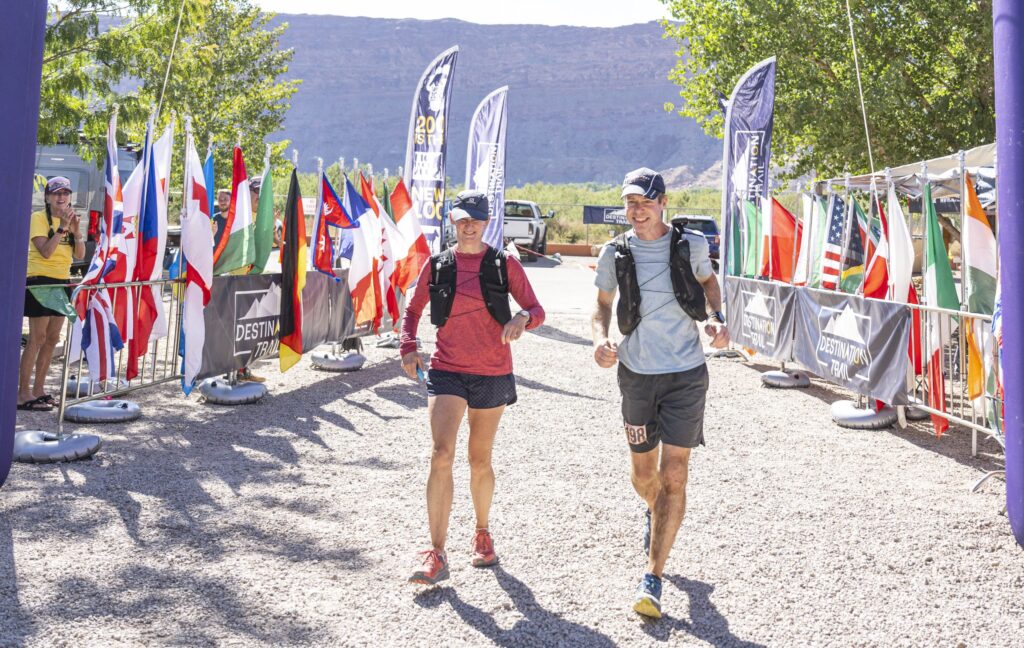
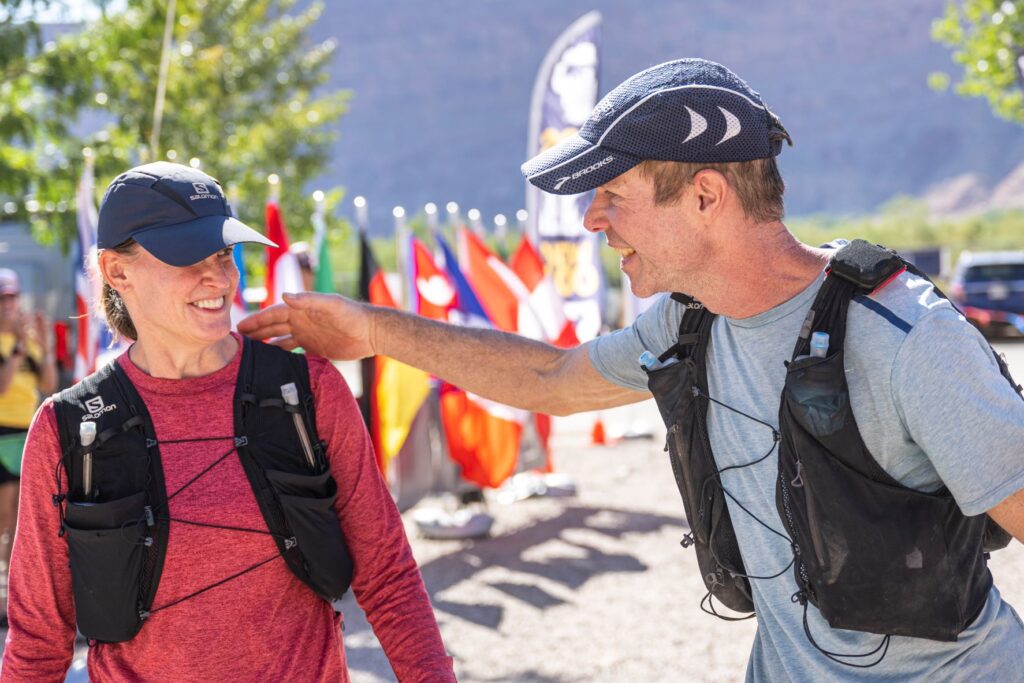
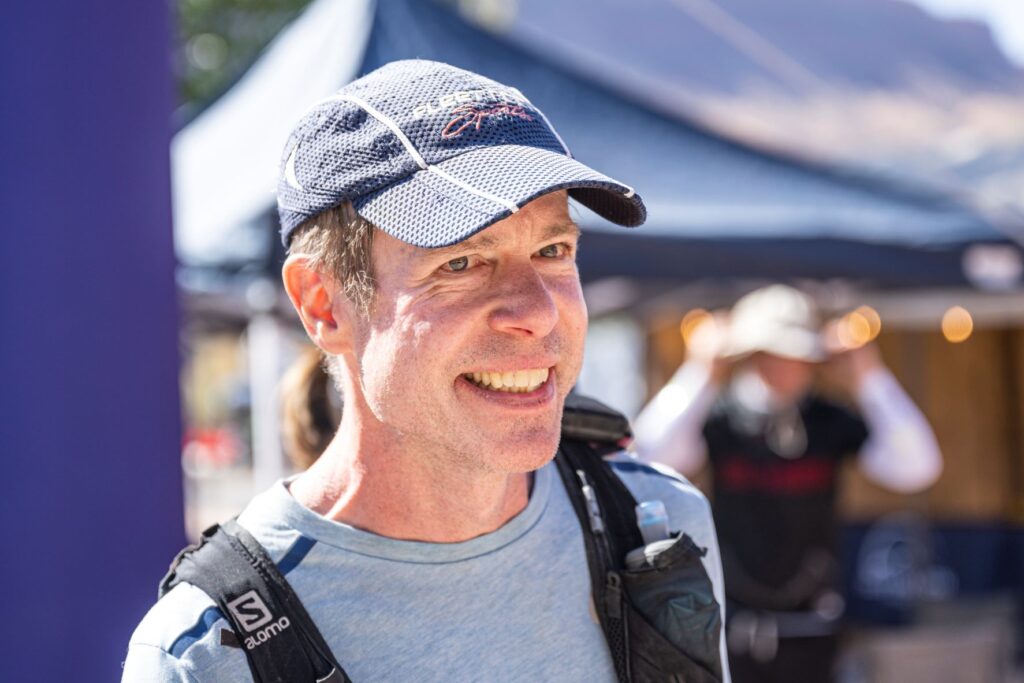
The Dreaded Lean
Following the race, I did a bit of research regarding the back issue that affected me toward the end of the race. There isn’t an abundance of material available on the subject, but after sifting through the articles I was able to find, what stood out to me were the specific root causes others had identified. Those root causes aligned very well with my own experience at Moab, so, although I can’t definitively state that these are the only root causes, I believe that they are at least two of the major causes. The root causes of the affliction are severe potassium depletion combined with sleep deprivation. It’s also worth noting that being of more advanced age makes one more susceptible to the lean, but isn’t a root cause in and of itself.
Root cause 1: lack of potassium. In the miles leading up to Shay Mountain aid station (mile 120) I started having difficulty consuming enough plantain chips and banana chips to sustain my energy levels, but I knew that mashed potatoes and pancakes had been working well at the aid stations. To ensure I was keeping the calories flowing in, beginning at Shay I carried mashed potatoes and pancakes in sandwich bags to eat while out on the trail. While white potatoes are potassium rich, pancakes have little to no potassium. I still carried some of the potassium rich banana chips I’d been relying on throughout the race, but once I had the more appetizing potatoes and pancakes in my pack, the chips were largely ignored. At some point, I believe I even told Heather to just leave the chips out of my pack. What made this shift in diet even more damaging was that the pancakes were going down more easily than the potatoes, so I ended up eating far more pancakes than potatoes.
My decision to switch to a different source of calories was not inherently a bad one. It gave me the fuel I needed to maintain my pace. But, once I’d stopped consuming the banana chips, I no longer had a significant source of potassium. My electrolyte drink, Skratch, contains trace amounts of potassium, but not enough to sustain the correct level in my body during constant physical activity. In past years, the salt capsules I used as supplements during the race contained potassium, but this year I’d switched to a “cleaner” salt capsule that had virtually no other elements beyond the sodium chloride which is salt. So, this capsule-based potassium source that had helped protect me in the past from the lean or other complications was now absent from my race nutrition.
Root cause 2: lack of sleep. I’ve addressed my severe sleep deprivation throughout the narrative, so I won’t bother repeating all of that here. Suffice it to say that I began the race already sleep deprived, and the condition only grew worse throughout the race. The hour and fifteen minutes of sleep at Road 46 helped me temporarily fight off the affects of my sleep deprivation, as did the 10-minute dirt naps I took a couple times later in the race, but ultimately, I was fighting a losing battle.
I never have these sleep issues prior to 100-mile races, only prior to the 200-milers. I believe this has something to do with the fact that I tend to view my 100-milers as less-serious ways to start my training season or to wrap up my racing season, whereas I view the 200-milers as events in which I enjoy being a more serious competitor. I’m sure that difference affects my subconscious in some manner that impacts my level of anxiety. Oddly though, I never lie in bed thinking about the race. I simply can’t sleep.
Finding Solutions: I am going to switch back to salt capsules that contain potassium, or will at least alternate them with the potassium-free capsules. I will also be more conscious of ensuring I am consistently eating foods that contain potassium at the aid stations and on the trail between aid stations. As for getting sleep the night before my races, this is still a work in progress. I’ve tried many things, all of which seem to help some of the time, but none of which work all of the time. Some of the things I’ve tried: melatonin, valerian root, doing stretching / yoga before bed, not focusing on the race the day before, reading a book before getting into bed, and avoiding using my computer or phone the day before the race as a means to avoid the screen light that tends to waken the brain.
Lack of sleep the night before the race is, hands-down, the single factor with the most negative impact on my race performance. I have made serious efforts in my last couple years of racing to eliminate this problem, and I have had some success. Bigfoot 200 this year is an example of one such success, when I slept 6 ½ hours the night before the race. I will continue working on this issue until I find what truly and consistently works for me.
Link to the “leaning” video
Departing Porcupine Rim. This video shows the lean and also highlights how my altered gait was causing me to drift to the right rather than walking straight down the road.
https://www.youtube.com/shorts/FZGFrTFyAO8
See you on the trails!
Wes Ritner